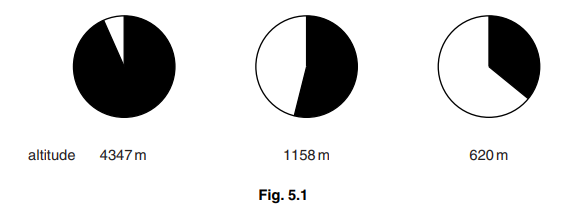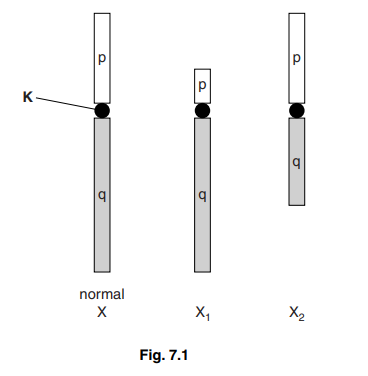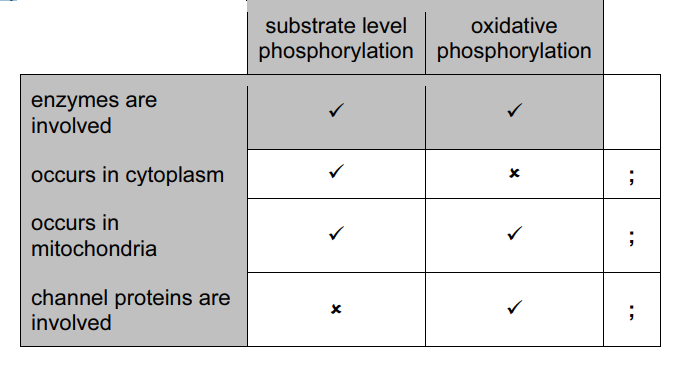Question
Deer mice, Peromyscus maniculatus, are small rodents that live in North America. Like all mammals, their blood contains haemoglobin which combines with oxygen in the lungs, and unloads its oxygen in respiring tissues.
Deer mice show variation in their genotypes for the genes that code for the α-polypeptide chain of haemoglobin. In most populations of deer mice, the majority of individuals have the genotype A1A1, while a smaller number have the genotype A0A0.
(a) In mice with the genotype A1A1, the amino acid at position 64 in the α-polypeptide chain is aspartic acid. In mice with the genotype A0A0, the amino acid at this position is glycine.
Suggest how the change from aspartic acid to glycine in the α-polypeptide chain could have been brought about.[2]
(b) The genotypes of deer mice from three different populations, each living at a different altitude, were analysed. Fig. 5.1 shows the relative proportions of deer mice with aspartic acid (white areas) and glycine (black areas) at position 64 in the α-polypeptide of
their haemoglobin.

(i) Describe the effect of altitude on the frequency of the haemoglobin alleles in these populations of deer mice.[2]
(ii) The partial pressure of oxygen is relatively low at high altitudes. Haemoglobin containing glycine at position 64 in the α-polypeptide chain has a higher affinity for oxygen than haemoglobin with aspartic acid at this position.
Suggest how natural selection could account for the difference in allele frequency in deer mice living at high altitudes and low altitudes.[4] [Total: 8]
Answer/Explanation
Ans:
5 (a) random/ spontaneous ;
mutation ;
base/nucleotide/triplet, change/ substitution ; R addition/ deletion
(b) (i) as altitude increases frequency of A0 increases ; ora for A1
A0 more frequent at high altitudes / A1 more frequent at low altitudes / intermediate frequency of either allele at intermediate altitude ;
(ii) idea of (pre-existing) genetic variation in deer mouse population ;
at high altitude mice with, glycine/A0, more likely to survive/ have selective advantage ; ora
mice (with A0 ) reproduce (at high altitude) ; ora
and pass on the A0 allele ; ora
partial pressure/ concentration, of O2 acts as a selection pressure ;
ref. to disadvantage of haemoglobin with very high affinity at low altitude ;
as less able to unload oxygen (in respiring tissues) ;
Question
Occasionally during meiosis, homologous chromosomes fail to separate at anaphase. This is known as non-disjunction. Turner’s syndrome is the most common chromosome mutation in human females. It can occur due to non-disjunction in meiosis during
gametogenesis. Some resulting gametes will be missing an X chromosome.
Some forms of Turner’s syndrome occur when one of the pair of X chromosomes is not missing but has become damaged. The damaged X chromosome may have been broken and re-formed so that part of its structure is lost.
Fig. 7.1 is a diagram of a normal X chromosome and two forms of ‘damaged’ X chromosomes, X1 and X2.
- In X1, a section of the ‘p’ arm of the chromosome is missing. This deletion leads to reduced height of the female and abnormalities such as narrowing of the aorta.
- In X2, a section of the ‘q’ arm of the chromosome is missing. This deletion leads to little or no development of the ovaries.

(a) Name structure K.[1]
(b) Explain why X1 and X2 result in different phenotypes.[2]
(c) Mothers with the X1 form of Turner’s syndrome can pass on the chromosome mutation to their daughters but not to their sons.
Complete the genetic diagram below to show how the chromosome mutation X1 may be passed on to daughters from a mother with Turner’s syndrome.[4]
parental female with normal male
phenotypes Turner’s syndrome
parental
genotypes XX1
gametes
genotypes of
daughters
phenotypes of
daughters
[Total: 7]
Answer/Explanation
Ans:
7 (a) centromere ;
(b) idea that different genes, are present/missing ; R alleles
different, proteins / poypeptides, produced/missing ;
(c) XY ;
X X1 X Y ;
XX XX1 ;
normal Turner’s ;
Question
In mice, the intensity of pigmentation of the fur is controlled by multiple alleles of a single gene.
The alleles are listed below in order of dominance, with C as the most dominant.
- C = full colour
- Cch = chinchilla
- Ch = himalayan
- Cp = platinum
- Ca = albino
(a) Explain how multiple alleles arise.[2]
(b) Eye colour in mice is controlled by two alleles of a single gene, B/b:
- allele B codes for black eyes
- allele b codes for red eyes.
A mouse with full colour fur and black eyes was crossed with a mouse with himalayan fur and black eyes. One of the offspring was albino with red eyes.
Using the symbols above, draw a genetic diagram to show the genotypes and phenotypes of the offspring of this cross.[6] [Total: 8]
Answer/Explanation
Ans:
8 (a) gene mutation ;
a change in the, base(s)/ nucleotide(s) ;
e.g. base, substitution/ deletion/ addition
(b) parental genotypes
CCaBb x ChCaBb ;
gametes
CB Cb CaB Cab x ChB Chb CaB Cab ; allow on Punnett square
offspring genotypes ; ; deduct one mark for each error
max 1 ecf for offspring genotypes if only 4 given
offspring phenotypes ;
phenotypes linked to genotypes ;

